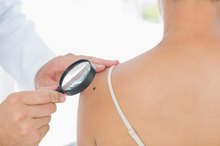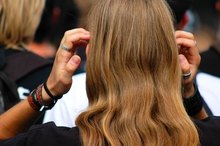Why Does the Sun Make Your Skin Darker But Your Hair Lighter?
Skin and hair react differently to sunlight. Typically, the skin darkens and the hair lightens, a result of a pigment in the human body called melanin.
Melanin darkens the skin to protect it from harmful solar radiation.
Because hair cells are not alive like skin cells are, melanin cannot protect hair from sun damage. Hair takes on a bleached appearance, while skin becomes darker. Precautions should be taken to limit exposure to ultraviolet light to prevent skin and hair damage.
Sunlight
Some of the sun’s rays are beneficial, but others, such as ultraviolet rays, are hazardous. This radiation comes in three forms: ultraviolet A (UVA), ultraviolet B (UVB) and ultraviolet C (UVC). The earth’s atmosphere filters out UVC radiation, but UVA and UVB affect you every day. UVB affects the top layers of skin, while UVA penetrates to the deeper layers. Your hair and your skin are negatively affected by these UV rays, although they appear to react differently.
- Some of the sun’s rays are beneficial, but others, such as ultraviolet rays, are hazardous.
- Your hair and your skin are negatively affected by these UV rays, although they appear to react differently.
Melanin
How to Stop Skin From Getting Darker From the Sun
Learn More
A pigment called melanin determines the color of your skin and hair. One form of melanin is a reddish-yellow color, while the other is brownish-black. The amount of each type of melanin you have in your skin and hair is genetically determined.
Melanin protects your skin from the sun’s harmful ultraviolet A and B rays by turning it a darker color.
People with very little melanin often acquire no tan and are at the greatest risk for sunburn, premature skin aging and skin cancer. People with dark skin should also be cautious about sun exposure.
- A pigment called melanin determines the color of your skin and hair.
Skin
Your skin is the largest organ in your body. It protects you from the sun’s harmful rays by producing the pigment melanin to darken your skin.
Ultraviolet rays in sunlight destroy the melanin in your skin, which triggers your body to produce more and darker melanin. This melanin reaction to ultraviolet rays can cause sunburn or suntan. UV radiation also causes the skin to coarsen and wrinkle, making even young skin look and feel old.
- Your skin is the largest organ in your body.
- Ultraviolet rays in sunlight destroy the melanin in your skin, which triggers your body to produce more and darker melanin.
Hair
Why Do Moles Grow Black Hair?
Learn More
Most of the hair on your body is made up of dead cells. Only the root is living, and once the hair emerges from the skin, the cells die. Melanin determines the color of your hair. People with very little melanin have blonde hair, while people with a great deal of melanin have black hair.
Unlike the skin, which can regenerate melanin after UV damage, your hair is dead and can no longer make melanin.
Sunlight kills the melanin in your hair and fades out the color, making it lighter and lighter. Your new hair will be as dark as before, since it contains the correct amount of melanin.
- Most of the hair on your body is made up of dead cells.
- Your new hair will be as dark as before, since it contains the correct amount of melanin.
Precautions
Although light-skinned, light-eyed people are at the greatest risk from UV radiation, the Skin Cancer Foundation urges everyone to limit their exposure 4.
Wearing sunscreens, broad-brimmed hats, tightly-woven, loose clothing and sunglasses helps fend off UV rays.
Keeping out of the sun as much as possible is the best option. This is especially true from 10:00 a.m. to 4:00 p.m. in the Northern Hemisphere.
The American Academy of Dermatologists points out that tanning damages your skin irreparably, especially if you use a tanning bed or sunlamp while in your teens 2.
These devices use the deeply-penetrating UVA rays to turn your skin darker, inuring your skin in the deeper layers. The damage to your skin may not appear until decades later.
- Although light-skinned, light-eyed people are at the greatest risk from UV radiation, the Skin Cancer Foundation urges everyone to limit their exposure 4.
- These devices use the deeply-penetrating UVA rays to turn your skin darker, inuring your skin in the deeper layers.
Related Articles
References
- Stanford School of Medicine: The Tech Museum
- American Academy of Dermatology: Darker side of tanning
- Burn Survivors Throughout the World: Sun Damage
- Skin Cancer Foundation: UV Information
- Kanitakis J. Anatomy, histology and immunohistochemistry of normal human skin. Eur J Dermatol. 2002 Jul-Aug;12(4):390-9.
- Habif TP. Clinical Dermatology E-Book. 5th ed. Elsevier Health Sciences; 2009.
- Dutton J, Gayre G, Proia A. Diagnostic Atlas of Common Eyelid Diseases. New York: Taylor & Francis Ltd.; 2007:1. doi:10.3109/9781420016321
- Alberts B, Johnson A, Lewis J, Raff M, Roberts K, Walter P. Molecular Biology of the Cell, 4th ed. New York: Garland Science; 2002.
- Kakasheva-Mazhenkovska L, Milenkova L, Gjokik G, Janevska V. Variations of the histomorphological characteristics of human skin of different body regions in subjects of different age. Prilozi. 2011;32(2):119-28.
- Sandby-Møller J, Poulsen T, Wulf HC. Epidermal thickness at different body sites: relationship to age, gender, pigmentation, blood content, skin type and smoking habits. Acta Derm Venereol. 2003;83(6):410-3. doi:10.1080/00015550310015419
- Rahrovan S, Fanian F, Mehryan P, Humbert P, Firooz A. Male versus female skin: What dermatologists and cosmeticians should know. Int J Womens Dermatol. 2018 Jun 22;4(3):122-130. doi:10.1016/j.ijwd.2018.03.002
Writer Bio
A freelance writer for more than 30 years, D.M. Gutierrez has had nonfiction, fiction and poetry published in women's, mystery, academic, children's, disability and teen print publications and websites including "Psychological Reports" and "Highlights for Children." She has an advanced degree in psychology from the University of California at Davis.









